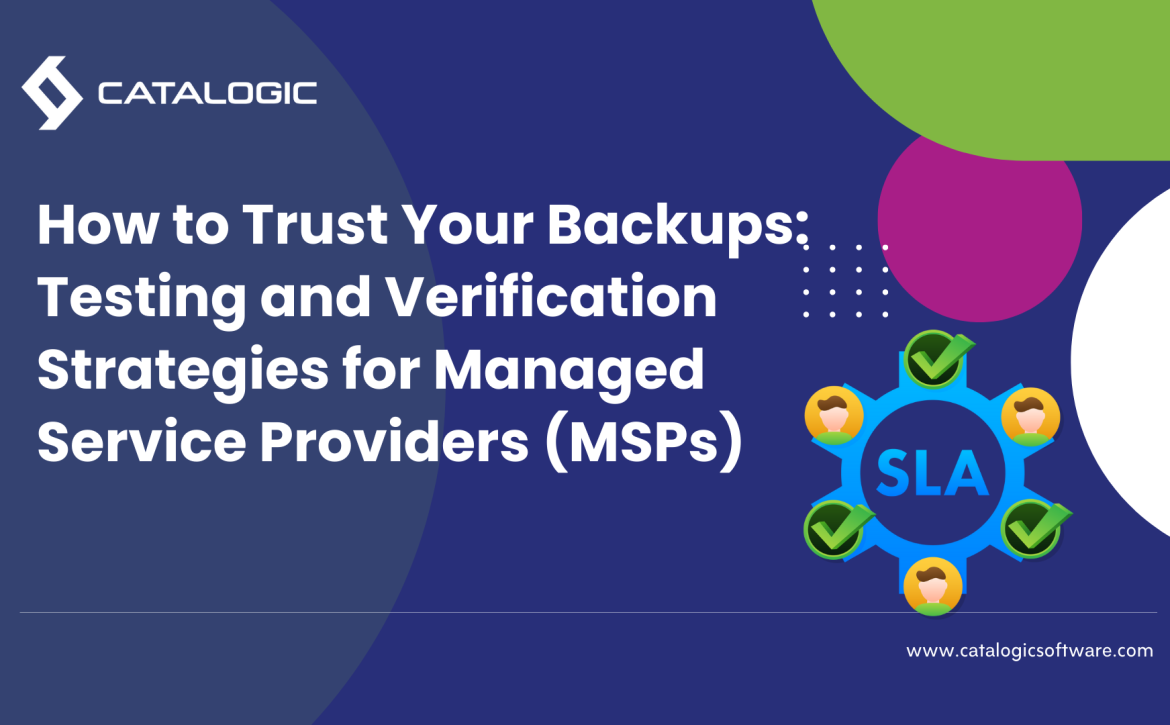How to Trust Your Backups: Testing and Verification Strategies for Managed Service Providers (MSPs)
 For Managed Service Providers (MSPs), backup management is one of the most critical responsibilities. A reliable MSP backup strategy is essential not only to ensure data protection and disaster recovery but also to establish client trust. However, as client bases grow, so does “backup anxiety”—the worry over whether a backup will work when needed most. To overcome this, Managed Service Providers can implement effective testing, verification, and documentation practices to reduce risk and confirm backup reliability.
For Managed Service Providers (MSPs), backup management is one of the most critical responsibilities. A reliable MSP backup strategy is essential not only to ensure data protection and disaster recovery but also to establish client trust. However, as client bases grow, so does “backup anxiety”—the worry over whether a backup will work when needed most. To overcome this, Managed Service Providers can implement effective testing, verification, and documentation practices to reduce risk and confirm backup reliability.
This guide explores the key strategies MSPs can use to validate backups, ease backup anxiety, and ensure client data is fully recoverable.
Why Backup Testing and Verification Are Crucial for Managed Service Providers
For any MSP backup solution, reliability is paramount. A successful backup is more than just a completion status—it’s about ensuring that you can retrieve critical data when disaster strikes. Regular testing and verification of MSP backups are essential for several reasons:
- Identify Hidden Issues: Even when backups report as “successful,” issues like file corruption or partial failures may still exist. Without validation, these issues could compromise data recovery.
- Preparation for Real-World Scenarios: An untested backup process can fail when it’s most needed. Regularly verifying backups ensures Managed Service Providers are prepared to handle real disaster recovery (DR) scenarios.
- Peace of Mind for Clients: When MSPs assure clients that data recovery processes are tested and documented, it builds trust and alleviates backup-related anxiety.
Key Strategies for Reliable MSP Backup Testing and Verification
To ensure backup reliability and reduce anxiety, Managed Service Providers can adopt several best practices. By combining these strategies, MSPs create a comprehensive, trusted backup process.
1. Automated Testing for MSP Backup Reliability
Automated backup testing can significantly reduce manual workload and provide consistent results. Managed Service Providers can set up automated test environments that periodically validate backup data and ensure application functionality in a virtual sandbox environment.
- How Automated Testing Works: Automated systems create an isolated test environment for backups. The system restores backups, verifies that applications and systems boot successfully, and reports any issues.
- Benefits: Automated testing provides MSPs with regular feedback on backup integrity, reducing the risk of data loss and allowing for early detection of potential problems.
2. Scheduled Manual Restore Tests
While automated testing is beneficial, Managed Service Providers should also perform regular manual restore tests to ensure hands-on familiarity with the recovery process. Conducting periodic manual restores validates backup reliability and prepares the MSP to handle live disaster recovery situations efficiently.
- Establish a Testing Schedule: Quarterly or biannual restore tests help MSPs verify data integrity without waiting for a real DR scenario.
- Document Restore Procedures: Detailed documentation of each restore process is essential, noting issues, time taken, and areas for improvement. This builds a knowledge base for the MSP team and provides a reliable reference in emergencies.
These scheduled tests enhance the MSP’s ability to respond confidently to data recovery needs.
3. Real-Time Backup Monitoring for MSPs
For MSPs, maintaining real-time visibility into backup health is key to proactive management. Setting up backup monitoring systems can keep Managed Service Providers informed of any backup status changes and minimize the likelihood of unnoticed failures.
- Custom Alerts: Customize alerts based on priority, enabling Managed Service Providers to act quickly when critical systems experience backup failures.
- Centralized Monitoring: Using centralized dashboards, MSPs can monitor backup status across multiple clients and systems. This reduces the dependency on individual notifications and provides a comprehensive view of backup health.
With consistent real-time monitoring, MSPs can maintain better control over their backup environments and reduce the risk of missed alerts.
4. Immutability and Secure Storage for MSP Backups
To ensure that backups are protected from tampering or deletion, Managed Service Providers should use secure, immutable storage solutions. Immutability protects data integrity by preventing accidental or malicious deletions, creating a trustworthy storage environment for sensitive data.
- Immutability Explained: Immutability locks backup files for a predetermined period, making them unalterable. This protects the data from accidental deletions and cyber threats.
- Implementing Secure Storage: MSPs can use both on-site and offsite immutable storage to secure data and meet the highest standards of backup safety.
Ensuring secure, immutable backups is a best practice that enhances data reliability and aligns with security requirements for Managed Service Providers.
Best Practices for MSP Backup Management to Reduce Anxiety
Managed Service Providers can further reduce backup anxiety by adhering to these best practices in backup management.
1. Follow the 3-2-1 Backup Rule
A core best practice for MSP backup reliability is the 3-2-1 rule: keep three copies of data (including the original), store them on two different media, and place one copy offsite. This strategy provides redundancy and ensures data remains accessible even if one backup fails.
- Implementing 3-2-1:
- Primary backup stored locally on dedicated hardware.
- Secondary backup stored on an external device.
- Third backup secured offsite in cloud storage.
The 3-2-1 approach strengthens backup reliability and ensures MSPs have multiple recovery options in a crisis.
2. Document Recovery Procedures and Testing
Comprehensive documentation of recovery procedures is essential for Managed Service Providers, especially in high-pressure DR situations. This documentation should cover:
- Recovery Objectives: Define Recovery Time Objective (RTO) and Recovery Point Objective (RPO) for each client.
- Clear Recovery Instructions: Detailed, step-by-step instructions ensure consistency in recovery procedures, reducing the risk of mistakes.
- Testing Logs and Reports: Keeping a record of every backup test, including any issues and lessons learned, provides insights for process improvement.
Thorough documentation helps MSPs streamline recovery processes and gives clients confidence in their disaster preparedness.
3. Offer Backup Testing as a Service
For Managed Service Providers, providing periodic backup testing as an additional service can offset the time and effort involved. Offering this as a premium service shows clients the value of proactive MSP backup testing and creates a new revenue stream for the MSP.
Testing not only supports DR but also improves clients’ confidence in the MSP’s ability to manage and verify backup reliability, adding value to the service relationship.
4. Use Cloud Backup Immutability and Retention Policies
For cloud backups, setting immutability and retention policies is essential to protect backup data and manage storage costs effectively. Retention policies allow MSPs to store backups only as long as necessary, balancing accessibility and cost management.
- Define Retention Policies: Create retention policies based on client requirements and data compliance standards.
- Verify Immutability: Ensure that all offsite storage solutions use immutability to protect data integrity and meet security standards.
Cloud backup immutability and retention policies help MSPs secure their data, improve compliance, and maintain efficient storage management.
Conclusion
Backup anxiety is a common challenge for Managed Service Providers, particularly as they scale their client base. But with a reliable testing regimen, continuous monitoring, and adherence to best practices, MSPs can build a solid, dependable backup strategy. These approaches not only reduce stress but also enhance client trust and satisfaction. 
By following these verification strategies and incorporating robust documentation, MSPs can move beyond backup anxiety, achieving confidence in their backup systems and providing clients with a reliable disaster recovery solution. With a proven, tested backup process, MSPs can shift from hoping their backups will work to knowing they’re reliable.

